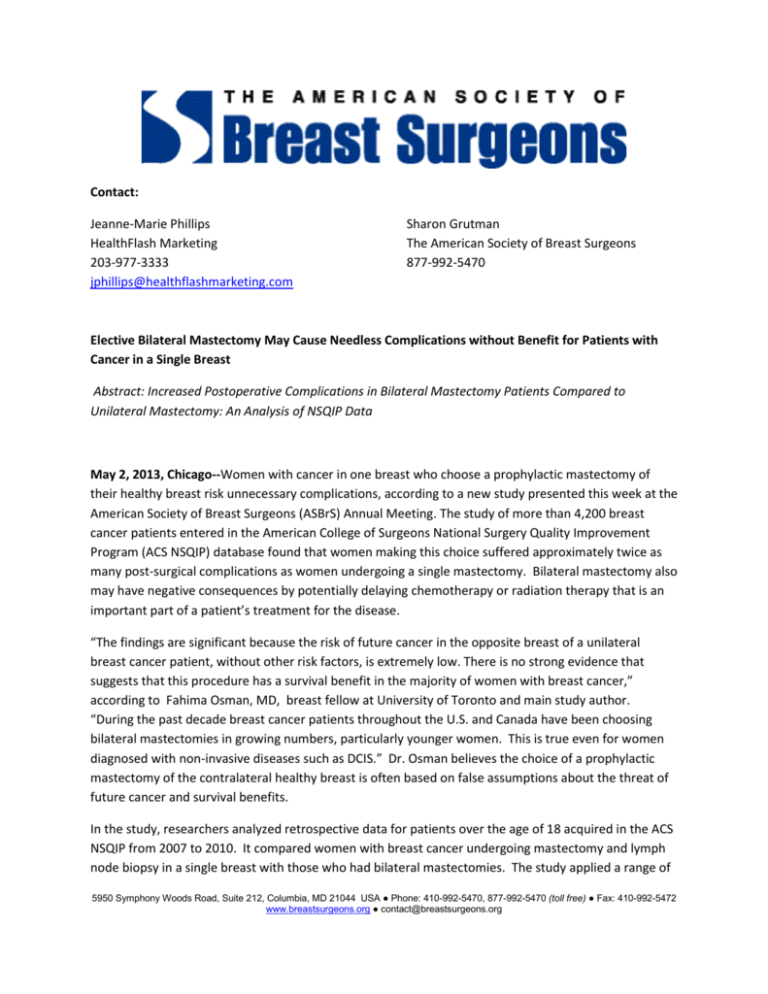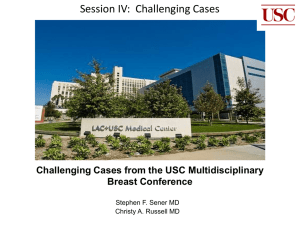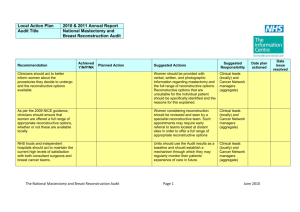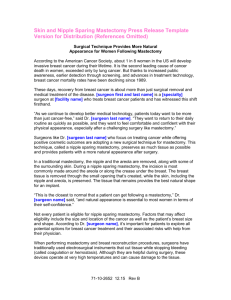MS-Word - American Society of Breast Surgeons
advertisement

Contact: Jeanne-Marie Phillips HealthFlash Marketing 203-977-3333 jphillips@healthflashmarketing.com Sharon Grutman The American Society of Breast Surgeons 877-992-5470 Elective Bilateral Mastectomy May Cause Needless Complications without Benefit for Patients with Cancer in a Single Breast Abstract: Increased Postoperative Complications in Bilateral Mastectomy Patients Compared to Unilateral Mastectomy: An Analysis of NSQIP Data May 2, 2013, Chicago--Women with cancer in one breast who choose a prophylactic mastectomy of their healthy breast risk unnecessary complications, according to a new study presented this week at the American Society of Breast Surgeons (ASBrS) Annual Meeting. The study of more than 4,200 breast cancer patients entered in the American College of Surgeons National Surgery Quality Improvement Program (ACS NSQIP) database found that women making this choice suffered approximately twice as many post-surgical complications as women undergoing a single mastectomy. Bilateral mastectomy also may have negative consequences by potentially delaying chemotherapy or radiation therapy that is an important part of a patient’s treatment for the disease. “The findings are significant because the risk of future cancer in the opposite breast of a unilateral breast cancer patient, without other risk factors, is extremely low. There is no strong evidence that suggests that this procedure has a survival benefit in the majority of women with breast cancer,” according to Fahima Osman, MD, breast fellow at University of Toronto and main study author. “During the past decade breast cancer patients throughout the U.S. and Canada have been choosing bilateral mastectomies in growing numbers, particularly younger women. This is true even for women diagnosed with non-invasive diseases such as DCIS.” Dr. Osman believes the choice of a prophylactic mastectomy of the contralateral healthy breast is often based on false assumptions about the threat of future cancer and survival benefits. In the study, researchers analyzed retrospective data for patients over the age of 18 acquired in the ACS NSQIP from 2007 to 2010. It compared women with breast cancer undergoing mastectomy and lymph node biopsy in a single breast with those who had bilateral mastectomies. The study applied a range of 5950 Symphony Woods Road, Suite 212, Columbia, MD 21044 USA ● Phone: 410-992-5470, 877-992-5470 (toll free) ● Fax: 410-992-5472 www.breastsurgeons.org ● contact@breastsurgeons.org 2 exclusionary criteria to achieve a homogenous population. Researchers also controlled for variables known to affect surgical complication rates, including body mass index, age, smoking status, hypertension, coronary artery disease and chronic obstructive pulmonary disease. The research found a statistically significant elevated wound complication rate, including infection and wound dehiscence, of 5.8% in the bilateral compared to 2.9% in the unilateral group. The overall surgical complication rate was 7.6% for bilateral and 4.2% for unilateral patients. While these risks did not vary with patient age, they significantly increased independently in women who were overweight or who smoke. “For a woman who has an early stage tumor in one breast with no other risk factors, the chance of suffering cancer in the contralateral breast is extremely small, less than 1% per year,” Dr. Osman notes. “This is especially true in the era of modern chemotherapy and endocrine therapy. These women would rarely benefit from a prophylactic mastectomy. However, it is important to note that women with genetic and other risk factors may have a clear benefit.” “There may be increased surgical complications as result of removing a healthy breast at the same time as the affected breast and we should counsel women appropriately about these risks. I certainly would advise an obese woman who smokes and is considering the prophylactic procedure to look at these risks carefully.” 5950 Symphony Woods Road, Suite 212, Columbia, MD 21044 ● Phone: 410-992-5470, 877-992-5470 (toll free) ● Fax: 410-992-5472 www.breastsurgeons.org ● contact@breastsurgeons.org 3 Abstract Presenter: Fahima Osman Institution: University of Toronto Serial #: 167 Title: Increased Postoperative Complications in Bilateral Mastectomy Patients Compared to Unilateral Mastectomy: An Analysis of NSQIP Data. Objectives: Recent studies have demonstrated that women with unilateral breast cancer are choosing contralateral prophylactic mastectomy (CPM) at an increasing rate. This is despite the well-established evidence of a low risk for future contralateral breast cancer, coupled with a lack of survival benefit. With the exception of a minority of high-risk patients that have the benefit of risk reduction with CPM, evidence suggests the majority of patients choose contralateral mastectomies based on fear of recurrence and perceived survival benefit. There is limited literature evaluating the post-operative complication rates associated with CPM without breast reconstruction. Using NSQIP data, we compared the postoperative complication rates in women undergoing unilateral mastectomy (UM) and sentinel lymph node biopsy (SLNB) to those undergoing bilateral mastectomy (BM) and SLNB for the treatment of their breast cancer. Method: This is a retrospective cohort study using the American College of Surgeons National Surgery Quality Improvement Program (ACS NSQIP) Participant Use Data Files between 2007-2010. Females older than 18 years of age with malignant breast disease undergoing UM were compared to those undergoing BM. Both groups underwent unilateral SLNB. Various exclusion criteria (e.g. ASA > 4, metastatic disease, immediate reconstruction cases) were applied to ensure a homogenous population. Individual and composite endpoints of 30-day complications were used to compare the UM and BM groups using both univariate and multivariate analyses. Results: We identified 4,219 patients that met the inclusion criteria for this study; 3,722 (88.2%) had UM while 497 (11.8%) patients had BM. The wound complication rate (which includes infection and wound dehiscence) was significantly higher in the BM group, 5.8% (n=29), versus the UM group, 2.9% (n=106). The unadjusted OR (95% CI, P-value) for wound complications comparing UM to BM was 2.1 (1.3- 3.3, <0.001). The overall 30-day complication rate in UM patients was 4.2% (n=164) vs. 7.6% (n=39) in the BM group. The unadjusted OR for overall complications comparing UM to BM was 1.88 (1.27 – 2.72, P < 0.001). The adjusted OR for overall complications adjusting for important patient characteristics was 1.92 (1.31- 2.82, P = 0.001). Independent predictors of overall post-operative complications were BMI (OR =1.05, P <0.001) and smoking (OR = 2.21, P <0.001). Table 1: Multivariable model of factors associated with overall post-operative complications. Model Variables BM vs. UM Age Diabetes Smoker BMI COPD OR (95% CI) 1.92 (1.31, 2.82) 1.01 (1.00, 1.02) 1.29 (0.86, 1.93) 2.21 (1.53, 3.19) 1.05 (1.03, 1.07) 1.26 (0.65, 2.41) P-value 0.001 0.132 0.213 <0.001 <0.001 0.495 5950 Symphony Woods Road, Suite 212, Columbia, MD 21044 ● Phone: 410-992-5470, 877-992-5470 (toll free) ● Fax: 410-992-5472 www.breastsurgeons.org ● contact@breastsurgeons.org 4 CAD HTN ASA 3 and 4* Chemotherapy 1.40 (0.79, 2.49) 1.02 (0.73, 1.43) 1.06 (0.76, 1.48) 0.89 (0.21, 3.75) 0.246 0.900 0.721 0.877 * Compared to groups ASA 1 and 2 Conclusions: Bilateral mastectomy is associated with an increased risk of wound complications and overall post-operative complications. The risk is even more marked among obese patients and smokers. Post-operative complications may impact on the timing and delivery of adjuvant chemotherapy and radiation. Discussion of the potential complications of bilateral mastectomy is imperative when counseling women contemplating CPM and the potential role in delaying their adjuvant treatment. 5950 Symphony Woods Road, Suite 212, Columbia, MD 21044 ● Phone: 410-992-5470, 877-992-5470 (toll free) ● Fax: 410-992-5472 www.breastsurgeons.org ● contact@breastsurgeons.org






